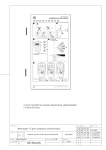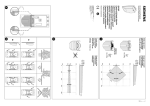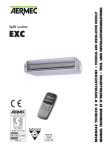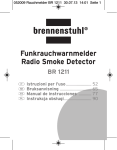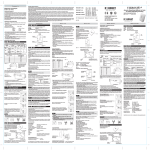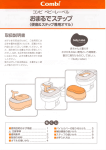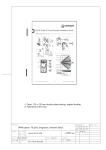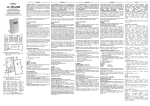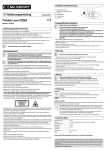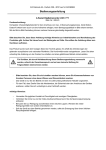Download VE1120 Series PIR Detector Installation Sheet
Transcript
VE1120 Series PIR Detector Installation Sheet EN DE ES FR IT NL PL PT SV 2 1 1 2 3 3 4 VE1120(AM) 20 m range (65 ft. 7 in.) 12 m (39 ft. 4 in.) 10 m (32 ft. 9 in.) 8 m (26 ft. 2 in.) 6 m (19 ft. 8 in.) 4 m (13 ft. 1 in.) 2 m (6 ft. 6 in.) 0m 2 m (6 ft. 6 in.) 4 m (13 ft. 1 in.) 6 m (19 ft. 8 in.) 8 m (26 ft. 2 in.) 10 m (32 ft. 9 in.) 12 m (39 ft. 4 in.) 4 m (optimum) 2.4 m (7 ft. 10 in.) 1.2 m (3 ft. 11 in.) 4 m (13 ft. 1 in.) 20.0 m (65 ft. 7 in.) © 2011 UTC Fire & Security. All rights reserved. 1 / 20 P/N 146279999-5 • REV 00.01 • ISS 29JUL11 5 VE1120 VE1120AM J1: Not used J3 and J4: See Figure 7. J6: J4 J3 J4 J3 CV + polarity CV – polarity J6 J1 J6 J1 6 2 / 20 P/N 146279999-5 • REV 00.01 • ISS 29JUL11 CP Zone Y 11 1 2 3 4 5 6 7 8 9 11 J3 10 J4 1 2 3 4 5 6 7 8 9 Normal 4.7 kΩ 9.4 kΩ Alarm Tamper 0Ω Short AM/TF 10 GND +12V Alarm Alarm Tamper Tamper WT D/N AM AM Rtest J3 GND +12V Alarm Alarm Tamper Tamper WT D/N AM AM Rtest 11 10 GND +12V Alarm Alarm Tamper Tamper WT D/N AM AM Rtest 1 2 3 4 5 6 7 8 9 J4 CP 8 1 2 3 4 5 6 7 8 J3 J4 GND +12V Alarm Alarm Tamper Tamper WT D/N AM AM Rtest GND +12V Alarm Alarm Tamper Tamper WT D/N 8 8 Zone X J4 J3 J4 Zone Y GND +12V Alarm Alarm Tamper Tamper WT D/N CP GND +12V Alarm Alarm Tamper Tamper WT D/N J3 1 2 3 4 5 6 7 8 GND +12V Alarm Alarm Tamper Tamper WT D/N J4 1 2 3 4 5 6 7 8 VE1120AM J3 Normal 4.7 kΩ 9.4 kΩ Alarm Tamper 0Ω Short Zone X 8 Zone X 8 Normal < 33 Ω Alarm VE1120 J4 11 CP Normal < 33 Ω Alarm 2 10 J3 J3 1 2 3 4 5 6 7 8 9 J4 Zone X J4 VE1120AM GND +12V Alarm Alarm Tamper Tamper WT D/N VE1120 1 2 3 4 5 6 7 8 1 GND +12V Alarm Alarm Tamper Tamper WT D/N AM AM Rtest 7 J4 Zone Y 8 8 Normal 4.7 kΩ 9.4 kΩ Alarm Tamper Short 0Ω AM/TF Zone X CP Zone X 8 Normal 4.7 kΩ 9.4 kΩ Alarm Tamper Short 0Ω 11 J3 10 1 2 3 4 5 6 7 8 9 1 2 3 4 5 6 7 8 J3 EN: Installation Sheet Introduction • Installing two detectors facing each other and less than 50 cm (20 in.) apart (only AM detectors) Installing the detector The VE1120 series includes the VE1120 PIR and VE1120AM PIR-AM motion sensors. They have a patented mirror, pyro, and signal processing technology. Figure 7 legend Note: VE1120AM has not been evaluated by UL/cUL. Installation guidelines The technology used in these detectors resists false alarm hazards. However, avoid potential causes of instability (see Figure 1) such as: • • • • • • Direct sunlight on the detector Strong draughts onto the detector Heat sources within the detector field of view Animals within the detector field of view Obscuring the detector field of view with large objects, such as furniture Objects within 50 cm (20 in.) of the anti-masking (AM) detector P/N 146279999-5 • REV 00.01 • ISS 29JUL11 Item Description 1. Standard connection (factory default) 2. Dual loop connection CP Control panel WT Walk test AM Antimasking D/N Day/night Rtest Remote test To install the detector: 1. 2. 3. Lift off the custom insert and remove the screw (see Figure 2, step 1). Using a screwdriver, carefully prise open the detector (see Figure 2, steps 2 and 3). Fix the base to the wall between 1.8 and 3.0 m (5.9 and 9.8 ft.) from the floor. For flat mounting use a minimum of 3 / 20 4. 5. 6. 7. 8. 9. two screws (DIN 7998) in positions A. For corner-mounting use screws in positions B or C (Figure 3). To install a pryoff tamper, use position A or C. Note: Using the pry-off tamper has not been evaluated by UL/cUL. Wire the detector (see Figures 3 and 7). UL/cUL installations: All wiring must be made according to National Electrical Code, NFPA70, and CSA C72.1, Canadian Electrical Code Part I, Safety Standards for Electrical Installations. Select the desired jumper and DIP switch settings (see Figure 5). See “Jumper settings” below for more information. Remove the blinders and add the stickers, if required (see Figure 6 for an example). For ceiling-mount applications that require a 90° coverage use the SB01 swivel-mount bracket. Note: Using the swivel-mount bracket has not been evaluated by UL/cUL. Ceiling mount application has not been evaluated by UL/cUL. Close the cover. Insert the screw and place the custom insert. • Controls the AM relay functionality during the NIGHT mode together with SW1. The WT input controls the LED functionality together with the D/N input. When the detector is in the Day mode and Walk Test On mode, the LEDs of the detector can be activated. See “LED indication” below for more information. During the Night mode the LEDs are always switched off. If a PIR intruder alarm if detected in the Night mode and the detector switches back to Day mode, the red LED starts flashing to indicate an alarm in memory. The alarm memory is reset by switching the detector to Night mode. DIP switch settings Factory default: 5 4 3 2 1 ON For EN 50131 Grade 3 installations, do not use mounting position B. SW 1: When to signal AM (anti-masking) or TF (technical fault) output Jumper settings On: Signals AM or TF only when the system is in Day mode (factory default). See Figure 5 for the jumper locations in the detector. Off: Always signals AM or TF during Day and Night mode. J1: Not used SW 2: AM sensitivity J3 and J4: Dual loop setting On: Selects a higher level of AM sensitivity. AM relay reacts within 6 seconds. This sets the alarm and tamper relays. It allows you to connect the detector to any control panel. Use jumpers 3 and 4. See Figure 7. Use Remote Test (RT) to test the detector from the control panel. The detector will activate the Alarm relay if the test result is positive, and the AM relay if the test result is negative. J6: Polarity setting of the control voltage (CV) On (factory default): • • • • The detector is in Day mode (system disarmed) when the D/N input is connected to GND (terminal 1) The detector is in Night mode (system armed) when the D/N input is connected to +12 V (terminal 2) The detector is in Walk Test Off mode (LEDs are disabled) when the WT input is connected to GND (terminal 1) The detector is on Walk Test On mode (LEDs are enabled) when the WT input is connected to +12 V (terminal 2) Off: • • • • The detector is in Day mode (system disarmed) when the D/N input is connected to +12 V (screw terminal 2). The detector is in Night mode (system armed) when the D/N input is connected to GND (terminal 1). The detector is in Walk Test Off mode (LEDs are disabled) when the WT input is connected to +12 V (terminal 2). The detector is on Walk Test On mode (LEDs are enabled) when the WT input is connected to GND (terminal 1). Off: Selects the standard AM sensitivity. AM relay reacts within 12 seconds (factory default). SW 3: Resetting the AM/TF output The system will only reset an AM alarm if it has ensured that the cause of the AM alarm has been removed. If the AM circuitry cannot return to its original reference levels, then either the detector is still masked or possibly has been damaged. The owner should then visually check that the detector is still fully functional. On: Resets the AM or TF status 40 seconds after a PIR alarm. Off: Resets the AM or TF status after a PIR alarm when the system is in Day and Walk Test mode. The yellow LED will blink quickly. When the system is in Night status, the yellow LED will turn off and the system is reset (factory default). SW 4: Signaling AM or TF output On: Signals AM on both the AM and Alarm relays. Signals TF on the AM relay only (EN 50131). Off: Signals AM and TF on the AM relay (factory default). SW 5: Setting LEDs On: Enables both LEDs on the detector at all times (factory default). Off: Puts both LEDs under the control of the Walk Test and Day/Night input. This activates the memory feature of the detector. D/N and WT functionality LED indication The D/N input: PIR • • Start up Controls the LED functionality together with the WT input. Resets the alarm memory 4 / 20 Red LED Yellow LED Alarm relay Closed AM relay To reset Automatically after 25 s P/N 146279999-5 • REV 00.01 • ISS 29JUL11 Low voltage Open (Alarm) Apply correct voltage PIR intruder alarm Open (Alarm) Automatically after 3 s PIR/AM Red LED Yellow LED Alarm relay AM relay To reset Start up Closed Closed Automatically after 60 s Low voltage Open (Alarm) Open (Alarm) Apply correct voltage PIR intruder alarm Open (Alarm) Switch to Night mode Open* (Alarm) Open (Alarm) After AM reset See DIP switch 3 Open (Alarm) VE1120AM 95% max. noncondensing (UL/cUL Installations) Weight 150 g IP/IK rating IP30 IK02 Regulatory information Manufacturer UTC Fire & Security Americas Corporation, Inc. 1275 Red Fox Rd., Arden Hills, MN 55112-6943, USA Authorized EU manufacturing representative: UTC Fire & Security B.V. Kelvinstraat 7, 6003 DH Weert, Netherlands Certification UL/cUL Switch to Night mode Technical fault Continuously on Relative humidity Automatically after 3 s Latched PIR (Memory) AM alarm VE1120 The product must be connected to a listed burglar system compatible control unit or power supply unit, which provides a minimum 4 hours of standby power and has a voltage output between 10 and 15 VDC. All wiring must be made according to National Electrical Code, NFPA70, and CSA C22.1, Canadian Electrical Code Part I, Safety Standards for Electrical Installations. Do a successful walk test Normal blinking (1 Hz) Perform walk test at least one per year. Use only a listed power-limited supply. Fast blinking (4 Hz) * Depends on the setting of the DIP switch SW4. VE1120AM has not been evaluated by UL/cUL. Specifications 2002/96/EC (WEEE directive): Products marked with this symbol cannot be disposed of as unsorted municipal waste in the European Union. For proper recycling, return this product to your local supplier upon the purchase of equivalent new equipment, or dispose of it at designated collection points. For more information see: www.recyclethis.info. VE1120 Detector VE1120AM PIR PIR with AM Signal processing V2E Range 20 m Optical 11 high-density mirror curtains Memory Yes Input power For UL/cUL installations 9 to 15 VDC (12 V nominal) 10 to 15 VDC (12 V nominal) Peak-to-peak ripple Detector start-up time For contact information see our Web site: utcfireandsecurity.com. 2 V (at 12 VDC) 25 s 60 s Normal current For UL/cUL installations 6.5 mA 0.078 W 10 mA — Current in alarm 1.2 mA 3.8 mA Maximum current (LED on) 11 mA 24 mA Mounting height Contact information 1.8 to 3.0 m (5.9 ft.to 9.8 ft.) DE: Installationsanweisungen Einführung Die Serie VE1120-D/VE1120AM-D besteht aus PIR/PIR-AMBewegungsmeldern. Letztere verfügen über einen patentierten Spiegel sowie Pyro- und Signalverarbeitungstechnologie. Dead zones 0.9 m (3 ft.) at minimum mounting height 1.5 m (5 ft.) at maximum mounting height Installationsanleitungen Target speed range 30 cm/s to 3 m/s (1 ft./s to 10 ft./s) 20 cm/s to 3 m/s (0.65 ft./s to 10 ft./s) Alarm (NC) / Tamper relay characteristic 80 mA, 30 VDC, resistive 80 mA, 30 VDC Die in diesen Meldern eingesetzte Technologie dient zur Vermeidung falscher Alarmmeldungen. Dennoch sollten Sie potenzielle Instabilitätsfaktoren vermeiden (Abb. 1), darunter: Pry-off tamper (not evaluated by UL/cUL) Optional Onboard (yes) AM relay characteristic — 80 mA at 30 VDC max. PIR Alarm time Operating temperature For UL/cUL installations Dimensions (H x W x D) • • • • • 3s • −10 to +55°C (14 to 130°F) 0 to 49°C ( 32 to 120°F ) • 125 × 55 × 60 mm (4.92 x 2.16 x 2.36 in.) P/N 146279999-5 • REV 00.01 • ISS 29JUL11 125 × 65 × 60 mm (4.92 x 2.6 x 2.36 in.) Direkte Sonneneinstrahlung auf den Melder Starke auf den Melder gerichtete Zugluft Hitzequellen innerhalb des Erfassungsbereichs Tiere innerhalb des Erfassungsbereichs des Melders Verdecken des Erfassungsbereichs des Melders durch große Objekte, z. B Möbel Objekte innerhalb von 50 cm des Melders mit Abdeckerkennung (AM) Montage zweier gegenüberliegender Melder in einem Abstand von weniger als 50 cm 5 / 20 Installation des Melders DIP-Schaltereinstellung Abbildung 7 Positionen Werkseinstellung: Position Beschreibung 1. Standard Anschaltung (Werkseinstellung) 2. Dual-MG Anschaltung CP Einbruchmeldezentrale WT Gehtest AM Abdeckerkennung D/N Scharf/Unscharf Rtest Ferntest 5 4 3 2 1 ON SW 1: Wann eine Abdeckungs(AM)- oder Technischer Fehler(TF)-Ausgabe signalisiert werden sollte Ein: Signalisiert AM oder TF nur, wenn sich das System im Tagbetrieb (unscharf) befindet (Werkseinstellung). Aus: Signalisiert AM oder TF immer im Scharf- und Unscharfbetrieb. SW 2: AM-Empfindlichkeit Installation des Melders: 1. 2. 3. 4. 5. 6. 7. 8. 9. Nehmen Sie die kundenspezifische Abdeckkappe ab und entfernen Sie die Schraube (Abb. 2, Schritt 1). Öffnen Sie den Melder vorsichtig mit einem Schraubendreher (Abb. 2, Schritte 2 und 3). Befestigen Sie die Basis in einem Abstand von 1,80 m bis 3 m vom Boden an der Wand. Verwenden Sie bei der Wandmontage mindestens 2 Schrauben (DIN 7998) in den Positionen A. Verwenden Sie für eine Eckmontage Schrauben in den Positionen B oder C (Abb. 3). Bei Installation eines Abreißkontakts, verwenden Sie die Positionen A oder C. Verkabeln Sie den Melder (Abb. 3 und 7). Wählen Sie die gewünschten Steckbrücken- und DIPSchaltereinstellungen aus (Abb. 5). Weitere Informationen finden Sie im Abschnitt „Steckbrückeneinstellungen“. Entfernen Sie die Spiegel-Abdeckungen und bringen Sie bei Bedarf die Aufkleber an (Abb. 6 enthält ein Beispiel) Verwenden Sie für Deckenmontagen, bei der eine Überwachung von 90° erforderlich ist, den Befestigungssatz für Wand- und Deckenmontagen (SB01). Schließen Sie die Abdeckung. Setzen Sie die Schraube und die kundenspezifische Abdeckkappe wieder ein. Ein: Wählt eine höhere Stufe der Abdeckungsempfindlichkeit aus. AM-Relais reagiert innerhalb von 6 Sekunden. Aus: Wählt die Standard-Abdeckungsempfindlichkeit aus. AMRelais reagiert innerhalb von 12 Sekunden (Werkseinstellung). SW 3: Zurücksetzen des AM/TF-Ausgangs Das System setzt einen AM-Alarm nur zurück, wenn sichergestellt ist, dass die Ursache des AM-Alarms behoben wurde. Wenn der AM-Schaltkreis nicht zu seiner ursprünglichen Referenzebene zurückkehren kann, ist entweder der Melder noch abgedeckt oder wurde möglicherweise beschädigt. Der Betreiber sollte dann nachschauen, ob der Melder noch voll funktionsfähig ist. Ein: Setzt den AM- oder TF-Status 40 Sekunden nach einem PIR-Alarm zurück. Aus: Setzt den AM- oder TF-Status nach einem PIR-Alarm zurück, wenn das System in den Unscharf- und GehtestModus geschaltet wurde. Die gelbe LED wird schnell blinken. Wenn sich das System im Scharfmodus befindet, erlischt die gelbe LED-Anzeige und das System wird zurückgesetzt (Werkseinstellung). SW 4: Signalisiert AM- oder TF-Ausgang Bei EN50131 Grad 3 Installationen darf die Montageposition B nicht verwendet werden. Ein: Signalisiert AM (Abdeckung) auf dem AM- und auf dem Alarmrelais. Signalisiert TF nur auf dem AM-Relais (EN 50131). Steckbrückeneinstellungen Aus: Signalisiert AM und TF auf dem AM-Relais (Werkseinstellung). Siehe Abbildung 5 für die Steckbrückenpositionen (J1-6) im Melder. J1: Nicht verwendet J3 und J4: Einstellung für Dual-Meldegruppe Dient zur Einstellung des Alarm- und Sabotagerelais. Sie können damit den Melder an eine beliebige Einbruchmeldezentrale anschließen. Verwenden Sie die Steckbrücken 3 und 4. Siehe Abbildung 7. Verwenden Sie den Ferntest (RT) um den Melder von der Zentrale aus zu testen. Der Melder aktiviert das Alarmrelais, wenn das Testergebnis positiv ist. Bei einem negativen Testergebnis wird das Abdeckungs (AM)-Relais aktiviert. J6: Polaritätseinstellung der Steuerspannung (CV) Ein: Der Signalpegel „Aktiv High“ aktiviert die Standard GE Security Logikfunktion für den Gehtest (WT), Alarmspeicher (D/N) und Ferntest (RT) Eingang (Werkseinstellung). SW 5: Einstellen von LEDs Ein: Aktiviert ständig beide LEDs auf dem Melder (Werkseinstellung). Aus: Beide LEDs werden durch den Eingang für Gehtest und durch die Einstellung für Scharf/Unscharf gesteuert. Dies aktiviert die Alarmspeicherfunktion des Melders. LED-Anzeige PIR Rote LED Gelbe AlarmLED relais AMZurücksetzen Relais Start Geschlossen Automatisch nach 25 Sek. Unterspannung Offen (Alarm) Verwenden Sie die korrekte Spannung PIREinbruchalarm Offen (Alarm) Automatisch nach 3 Sek. Aus: Der Signalpegel „Aktiv low“ aktiviert die Logikfunktion für den Gehtest (WT), Alarmspeicher (D/N) und Ferntest (RT) Eingang. 6 / 20 P/N 146279999-5 • REV 00.01 • ISS 29JUL11 PIR/AM Rote LED Gelbe Alarm- AMZurücksetzen LED relais Relais Start Gesch- Gesch- Automatisch nach lossen lossen 60 Sek. Unterspannung Offen Offen Verwenden Sie die (Alarm) (Alarm) korrekte Spannung PIREinbruchalarm Offen (Alarm) Automatisch nach 3 Sek. PIR-Speicher Hersteller Zertifizierung 2002/96/EC (WEEE): Produkte die mit diesem Symbol gekennzeichnet sind, dürfen nicht als unsortierter städtischer Abfall in der europäischen Union entsorgt werden. Für die korrekte Wiederverwertung bringen Sie dieses Produkt zu Ihrem lokalen Lieferanten nach dem Kauf der gleichwertigen neuen Ausrüstung zurück, oder entsorgen Sie das Produkt an den gekennzeichneten Sammelstellen. Weitere Informationen hierzu finden Sie auf der folgenden Website: www.recyclethis.info. Offen* Offen Siehe DIP-Schalter (Alarm) (Alarm) 3 Nach Zurücksetzen von AM Schalten Sie 1 x Scharf/Unscharf Technischer Fehler Offen Führen Sie einen (Alarm) erfolgreichen Gehtest durch Kontaktinformation Normales Blinken (1 Hz) Kontaktinformationen erhalten Sie von unserer Webseite: utcfireandsecurity.com. Schnell blinkend (4 Hz) * Abhängig von der Einstellung von DIP-Schalter SW4. Technische Daten Melder VE1120-D VE1120AM-D PIR PIR + AM Signalauswertung V2E Reichweite 20 m Optik 11 Spiegelvorhänge mit hoher Dichte Speicher Versorgungsspannung Spitze/SpitzeBrummspannung Meldereinschaltzeit Ja 9 bis 15 V Gleichspannung (12 V nominal) 2 V (bei 12 V Gleichspannung) 25 s 60 s Normale Stromaufnahme 6.5 mA 10 mA Stromaufnahme bei Alarm 1.2 mA 3.8 mA Maximale Stromaufnahme 11 mA 24 mA Montagehöhe Min. 1.8 m, max. 3.0 m Erfassungsgeschwindigkeitsbereich 20 cm/s bis 3 m/s Eigenschaften Alarm(NC) / Sabotagerelais 80 mA, 30 VDC 80 mA, 30 VDC Optional Intern (Ja) — 80 mA bei 30 V Gleichspannung max. Abreisskontakt Eigenschaften AM-Relais Abmessungen (H x B x T) La gama VE1120/VE1120AM está fabricada con sensores de movimiento PIR/PIR-AM. Cuentan con tecnología patentada de espejos, sensores piroeléctricos y procesamiento de la señal. Instrucciones para la instalación La tecnología utilizada en estos detectores resiste riesgos de falsas alarmas. Sin embargo, debe evitar posibles causas de inestabilidad, como por ejemplo (consulte la figura 1): • • • • • • • Luz solar directa en el detector Fuertes corrientes de aire sobre el detector Fuentes de calor dentro del campo de visión del detector Animales dentro del campo de visión del detector Oscurecer el campo de visión del detector con objetos de gran tamaño, como por ejemplo mobiliario Objetos a menos de 50 cm del detector antimáscara (AM) Instalar dos detectores uno en frente del otro a menos de 50 cm de distancia Instalación del detector Figura 7 elementos Elemento Descripción 1. Conexión estandar (Valores por defecto) −10 bis +55°C 2. Conexión Doble resistencia CP Panel de control Max. 95% WT Prueba de paseo 150 g AM Antimáscara IP30 IK02 D/N Día/Noche Rtest Prueba remota Gewicht IP/IK-Einstufung Introducción 3s 125 × 55 × 60 mm Relative Luftfeuchtigkeit ES: Instrucciones de instalación 10 cm/s bis 4 m/s Alarmdauer Betriebstemperatur UTC Fire & Security Americas Corporation, Inc. 1275 Red Fox Rd., Arden Hills, MN 55112-6943, USA Autorisierter EU-Herstellungsrepräsentant: UTC Fire & Security B.V. Kelvinstraat 7, 6003 DH Weert, Niederlande Schalten Sie 1 x Scharf/Unscharf AM-Alarm Ständig An Zertifizierung und Einhaltung 125 × 65 × 60 mm Hinweise für VdS-Installationen In VdS-Installationen muß ein VdS-Plombiersiegel über den Deckel und den Meldersockel geklebt werden. Die VdSPlombiersiegel können unter der Bestellnummer Aritech VS00 (50 Siegel pro Blatt) bestellt werden. P/N 146279999-5 • REV 00.01 • ISS 29JUL11 Instalación del detector: 1. Levante la tapa de la carcasa retire el tornillo (consulte la figura 2, paso 1). 7 / 20 2. Usando un destornillador, abra el detector con cuidado (consulte la figura 2, pasos 2 y 3). Fije la base a la pared a una altura de entre 1,8 m y 3 m del suelo. Para montaje plano utilice un mínimo de dos tornillos (DIN 7998) en las posiciones A. Para los montajes en esquinas los tornillos tienen que colocarse en las posiciones B o C (figura 3). Para instalar un tamper de pared, utilice las posiciones A o C. Conecte los cables del detector (consulte las figuras 3 y 7). Seleccione la configuración de puente e interruptor DIP que desee (consulte la figura 5). Consulte la sección “Configuración de puentes” más adelante para obtener más información. Retire las máscaras y pegue las etiquetas si es necesario (consulte la figura 6 como ejemplo). Para aplicaciones de montaje en el techo que precisen de una cobertura de 90º utilice el soporte de montaje giratorio SB01. Cierre la carcasa. Ponga el tornillo en su sitio y vuelva a colocar la tapa de la carcasa. 3. 4. 5. 6. 7. 8. 9. Para instalaciones EN 50131 grado 3, no utilice la posición B de montaje. Configuración de puentes Consulte la figura 5 para saber dónde están situados los puentes en el detector. INTERRUPTOR 2: Sensibilidad de AM Activado: Selecciona un nivel más alto de sensibilidad de AM. El relé de AM reacciona a los 6 segundos. Desactivado: Selecciona la sensibilidad estándar de AM. El relé de AM reacciona a los 12 segundos (programación por defecto). INTERRUPTOR 3: Restablecimiento de la salida AM/FT El sistema sólo restablecerá una alarma de AM si tiene total seguridad de que la causa de la alarma de AM se ha eliminado. Si el circuito de AM no puede volver a sus niveles de referencia originales, entonces es que el detector aún está enmascarado o que ha sufrido algún posible daño. En este caso, el propietario debe examinar el detector y comprobar que aún está totalmente operativo. Activado: Restablece los estados de AM o FT 40 segundos después de una alarma PIR. Desactivado: Restablece el estado de AM o FT después de una alarma PIR si el sistema está en los estados de Prueba de paseo y Día. El indicador LED amarillo parpadeará rápidamente. Si el sistema está en estado Noche, el indicador LED amarillo se apagará y el sistema se restablecerá (programación por defecto). INTERRUPTOR 4: Señalización de salida AM o FT Activado: Señala AM en el relé de AM y el relé de alarma. Señala FT en el relé de AM solamente (EN 50131). PJ1: No se utiliza Desactivado: Señala AM y FT en el relé de AM (programación por defecto). PJ3 y PJ4: Configuración de bucle doble INTERRUPTOR 5: Configuración de indicadores LED Configura los relés de alarma y tamper. Le permite conectar el detector a cualquier panel de control. Utilice los puentes 3 y 4. Consulte la figura 7. Activado: Activa ambos LED en el detector en todo momento (programación por defecto). Utilice el test remoto (RT) para probar el detector desde el panel de control. El detector activará el relé de alarma si la prueba da resultados positivos, y el relé de AM si la prueba da resultados negativos. Desactivado: Pone a ambos indicadores LED bajo el control de las entradas Prueba de paseo y Día/Noche. Esto activa la función de memoria del detector. Indicación LED Automáticamente después de 25 s Tensión baja Desactivado: “Active Low” (Activo bajo) permite la lógica “Activa por nivel bajo” para habilitar entradas de Prueba de paseo — Walk Test (WT), Día/Noche — Day/Night (D/N) y Prueba remota — Remote Test (RT). Abierto (alarma) Aplicar el voltaje adecuado Alarma PIR de intruso Abierto (alarma) Automáticamente después de 3 s 3 2 1 Inicio Cerrado Cerrado Automáticamente después de 60 s Tensión baja Abierto Abierto Aplicar el voltaje (alarma) (alarma) adecuado Alarma PIR de intruso Abierto (alarma) ON INTERRUPTOR 1: Para señalar la salida AM (antimáscara) o FT (fallo técnico) Activado: Señala AM o FT sólo cuando el sistema está en modo Día (programación por defecto). Desactivado: Siempre señala AM o FT en el modo Día y Noche. 8 / 20 Restablecimiento 4 Relé de AM 5 Relé de alarma Programación por defecto: LED amarillo LED rojo PIR/AM Configuración de interruptor DIP Restable cimiento Cerrado Relé de AM Inicio Relé de alarma Activado: “Active High” (Activo alto) permite la lógica estándar GE Security con lógica “Activa por nivel alto” para habilitar entradas de Prueba de paseo — Walk Test (WT), Día/Noche — Day/Night (D/N) y Prueba remota — Remote Test (RT) (Programación por defecto). LED amarillo PIR LED rojo PJ6: Configuración de polaridad del voltaje de control (VC) PIR cerrado (memoria) Automáticamente después de 3 s Cambio a modo Noche P/N 146279999-5 • REV 00.01 • ISS 29JUL11 Alarma AM Certificado Restablecimiento Relé de AM Relé de alarma LED amarillo LED rojo PIR/AM 2002/96/EC (WEEE): Los productos marcados con este símbolo no se pueden eliminar como basura normal sin clasificar en la Unión Europea. Para el reciclaje apropiado, devuelva este producto a su distribuidor al comprar el nuevo equipo equivalente, o deshágase de él en los puntos de reciclaje designados. Para mas información : www.recyclethis.info. Abierto* Abierto Ver interruptor (alarma) (alarma) DIP 3 Después de restablecer AM Cambio a modo Noche Fallo técnico Abierto Realizar una (alarma) prueba de paseo con éxito Encendido de forma continua Parpadeo normal (1 Hz) Información de contacto Para información de contacto visite nuestro sitio Web: utcfireandsecurity.com. Parpadeo rápido (4 Hz) *Dependiendo de la programacion de los microinterruptores SW4. FR: Manuel d’installation Especificaciones técnicas Detector VE1120 VE1120AM PIR PIR + AM Procesamiento de la señal V2E Alcance 20 m Óptico La gamme VE1120/VE1120AM est constituée de détecteurs de mouvements IRP/IRP-AM. Ceux-ci possèdent une technologie brevetée de miroir, capteur pyro et traitement du signal. 11 cortinas de espejo de alta densidad Memoria Instructions d'installation Sí Alimentación de entrada 9 a 15 VCC (12 V nominal) Onda de pico a pico Tiempo de arranque del detector 2 V (a 12 VCC) 25 s 60 s Consumo de corriente en estado normal 6.5 mA 10 mA Consumo de corriente en alarma 1.2 mA 3.8 mA Consumo máximo de corriente 11 mA 24 mA Altura de instalación 20 cm/s a 3 m/s (0.65 ft./s a 10 ft./s) Característica del relé de alarma (NC) / tamper 80 mA, 30 VDC 80 mA, 30 VDC Opcional En la placa (Sí) — 80 mA a 30 VCC máx. Característica del relé de AM Dimensiones (Al x An x Pro) Humedad relativa • • L’exposition du détecteur à la lumière directe du soleil Les courants d’air puissants sur le détecteur Les sources de chaleur dans le champ de vision du détecteur La présence d'animaux dans le champ de vision du détecteur L’obstruction du champ de vision du détecteur par des objets volumineux, comme des meubles La présence d’objets à moins de 50 cm du détecteur antimasque (AM) L’installation de deux détecteurs face à face à moins de 50 cm de distance Installation du détecteur Figure 7 légende Numéro Description 3s 1. Connexion standard (défaut usine) −10 a +55°C (14 a 130°F) 2. Connexion double boucle CP Centrale WT Test de marche AM Anti-masque D/N Jour/Nuit Rtest Test à distance Tiempo de alarma Temperatura de funcionamiento • • • • Mín. 1.8 m, máx. 3.0 m (Mín. 5.90 ft., máx. 9.84 ft.) 30 cm/s a 3 m/s (1 ft./s a 10 ft./s) Tamper de pared La technologie utilisée dans ces détecteurs est conçue pour résister aux risques de fausses alarmes. Toutefois, il est conseillé d’éviter les causes d'instabilité potentielles, telles que (voir fig. 1) : • Rango de velocidades de destino 125 × 55 × 60 mm (4.92 x 2.16 x 2.36 in.) 125 × 65 × 60 mm (4.92 x 2.6 x 2.36 in.) Máx. 95% Peso Rango de IP/IK Introduction 150 g IP30 IK02 Installation du détecteur: Certificados y homologaciones Fabricante UTC Fire & Security Americas Corporation, Inc. 1275 Red Fox Rd., Arden Hills, MN 55112-6943, USA Representante autorizado en UE del fabricante: UTC Fire & Security B.V. Kelvinstraat 7, 6003 DH Weert, Holanda P/N 146279999-5 • REV 00.01 • ISS 29JUL11 1. 2. 3. Soulevez le couvercle et retirez la vis (voir fig. 2, étape 1). A l’aide d’un tournevis, ouvrez délicatement le détecteur en faisant levier (voir fig. 2, étapes 2 et 3). Fixez la base au mur à une hauteur comprise entre 1,8 m et 3 m du sol. Pour un montage à plat utiliser au minimum deux vis (DIN 7998) en position A. Pour le montage en 9 / 20 La boucle double permet de régler les relais d’alarme et d’autoprotection. Elle permet de connecter le détecteur à tout type de centrale. Elle utilise les cavaliers 3 et 4. Voir fig. 7. Utiliser l'entrée Test à distance (RT) pour tester le détecteur à partir de la centrale. Le détecteur active le relais d’alarme si le résultat du test est positif et le relais AM si le résultat du test est négatif. J6 : Réglage de la polarité de tension de contrôle (TC) Activé : « Sortie active » fournit la logique GE Security standard avec une sortie active pour activer les entrées test de marche (WT), jour/nuit (D/N) et Test à distance (RT). Sortie d’usine. Désactivé : « Sortie non active » fournit une sortie non active pour activer les entrées test de marche (WT), jour/nuit (D/N) et test à distance (RT). Désactivé : Met les deux témoins sous contrôle des entrées test de marche et jour/nuit. Ceci active la fonction de mémoire du détecteur. Explication des témoins IRP Démarrage Fermé Automatiquement après 25 s Basse tension Ouvert (alarme) Utiliser une tension correcte Alarme intrusion IRP Ouvert (alarme) Automatiquement après 3 s IRP/AM Réglage commutateur DIP Sortie d’usine: 5 4 3 2 1 ON SW 1 : Quand signaler les sorties AM (anti-masque) ou PT (problème technique) Activé : Signale les alarmes AM ou PT uniquement quand le système est en mode jour (sortie d’usine). Désactivé : Signale toujours l’AM ou le PT en mode Jour et Nuit. SW 2 : Sensibilité d’anti-masque Activé : Augmente la sensibilité d’anti-masque. Le relais AM réagit en moins de 6 secondes. Désactivé : Sélectionne la sensibilité d’anti-masque standard. Le relais AM réagit en moins de 12 secondes (sortie d’usine). SW 3 : Réinitialisation des sorties AM/PT Le système réinitialise une alarme AM une fois qu’il est sûr que la cause de l’alarme AM a été supprimée. Si le circuit AM ne peut pas revenir à ses niveaux de référence d’origine, soit le détecteur est toujours masqué, soit il a été endommagé. Le 10 / 20 Réinitialisa tion J3 et J4 : Configuration de la boucle double Activé : Active en permanence les deux témoins lumineux du détecteur (sortie d’usine). Réinitialisa tion J1 : Non utilisé SW 5 : Réglage des témoins lumineux Relais AM Reportez-vous à la figure 5 pour connaître les emplacements du cavalier dans le détecteur. Désactivé : Signale les sorties AM et PT sur le relais AM (sortie d’usine). Relais AM Réglage du cavalier Activé : Signale les sorties AM à la fois sur les relais AM et d’alarme. Signale les sorties PT sur le relais AM uniquement (EN 50131). Relais d'alarme Pour les installations EN 50131 Grade 3, ne pas utiliser le montage en position B. SW 4 : Signalisation des sorties AM ou PT Relais d'alarme 8. 9. Témoin jaune 7. Désactivé : Réinitialise l’état AM ou PT suite au déclenchement d’une alarme IRP, lorsque le système est en mode jour et test de marche. Le témoin jaune clignote rapidement. Lorsque le système est en état nuit, le témoin jaune s’éteint et le système se réinitialise (sortie d’usine). Témoin jaune 6. Activé : Réinitialise l’état AM ou PT 40 secondes après une alarme IRP. Témoin rouge 4. 5. propriétaire doit alors vérifier physiquement si le détecteur est toujours fonctionnel. Témoin rouge coin, utilisez les vis en positions B ou C (fig. 3). Utiliser la position A ou C pour installer l'autoprotection. Raccordez le détecteur (voir figures 3 et 7). Sélectionnez le cavalier requis et la configuration des commutateurs DIP (voir fig. 5). Pour plus d’informations, consultez la section « Réglage du cavalier » ci-dessous. Retirez les masques et ajoutez les autocollants si nécessaire (voir fig. 6 pour exemple). Pour les applications de montage au plafond requérant une couverture de 90°, utilisez la patte de fixation à pivot SB01. Fermez le panneau de couverture. Insérez la vis et remettez le couvercle en place. Démarrage Fermé Basse tension Ouvert Ouvert Utiliser une tension (alarme) (alarme) correcte Alarme intrusion IRP Ouvert (alarme) IRP verrouillé (mémoire) Automatiquement après 60 s Automatiquement après 3 s Passer au mode nuit Alarme AM Ouvert* Ouvert Voir commutateur (alarme) (alarme) DIP 3 Après réinitialisation de l’AM Passer en mode nuit Problème technique Allumé en continu Fermé Ouvert Réussir un test de (alarme) marche Clignotement normal (1 Hz) Clignotement rapide (4 Hz) * Dépend du paramétrage du commutateur DIP SW4. P/N 146279999-5 • REV 00.01 • ISS 29JUL11 Spécifications techniques Détecteur VE1120AM : NFA2P grade 3 n°263110009 VE1120 VE1120AM IRP IRP + AM Traitement du signal V2E Catégorie 20 m Optique 11 miroirs à rideau haute densité Mémoire Oui Puissance d’entrée Ondulation crête à crête Temps de démarrage du détecteur 2 V (à 12 V CC) 25 s 60 s Consommation électrique normale 6.5 mA 10 mA Consommation actuelle en mode Alarme 1.2 mA 3.8 mA Consommation électrique maximale 11 mA 24 mA Hauteur de montage Vitesse cible Caractéristiques du relais d’alarme (NC) / d’autoprotection Protection contre l’arrachement Caractéristiques du relais AM De 30 cm/s à 3 m/s De 20 cm/s à 3 m/s 80 mA, 30 V CC 80 mA, 30 V CC Non Oui — 80 mA à 30 V CC max. AFNOR Certification www.afnor.org 2002/96/EC (WEEE): Les produits marqués de ce symbole peuvent pas être éliminés comme déchets municipaux non triés dans l'Union européenne. Pour le recyclage, retourner ce produit à votre fournisseur au moment de l'achat d'un nouvel équipement équivalent, ou à des points de collecte désignés. Pour plus d'informations, voir: www.recyclethis.info. Température de fonctionnement De −10 C à +55 C 125 × 55 × 60 mm Humidité relative Pour de plus amples informations consulter notre site internet: utcfireandsecurity.com. IT: Istruzioni per l'installazione 125 × 65 × 60 mm La famiglia VE1120/1120AM è costituita da rivelatori di movimento PIR/PIR-AM. Sono dotati di uno specchio brevettato, sensore pirolettrico ed elaborazione del segnale. Max. 95% Poids 150 g Classe IP/IK Contact Introduzione 3s IP30 IK02 Certification et conformité Fabriquant CNPP Cert www.cnpp.com - NF324 H58 Min. 1.8 m, max. 3.0 m Temps d’alarme Dimensions (H x L x P) Classe d’environnement II Certifié suivant les référentiels : - EN50131-2-2 - RTC50131-2-2 9 à 15 V CC (12 V nominal) UTC Fire & Security Americas Corporation, Inc. 1275 Red Fox Rd., Arden Hills, MN 55112-6943, USA Mandataire agréé UE: UTC Fire & Security B.V. Kelvinstraat 7, 6003 DH Weert, Pays-Bas Certification Linee guida per l'installazione La tecnologia utilizzata per questi rivelatori è a prova di falsi allarmi. È tuttavia necessario evitare potenziali cause di instabilità, quali (vedere la fig. 1): • • • • • • Esposizione del rivelatore alla luce solare diretta Forti correnti d'aria in prossimità del rivelatore Fonti di calore nel campo visivo del rivelatore Animali nel campo di copertura del rilevatore Oscuramento del campo visivo del rivelatore con oggetti di grandi dimensioni (es. mobilio) Presenza di oggetti nel raggio di 50 cm dal rivelatore antimascheramento (AM) Installazione di due rivelatori l'uno di fronte all'altro a meno di 50 cm di distanza Remarque importante VE1120AM : lors d’une installation en association avec la rotule SB01, il est obligatoire d’utiliser le kit de détection d’arrachement référence ST400, afin que le produit soit conforme à sa certification NFA2P. • VE1120 : NFA2P grade 2 n°26211000010 Figura 7 oggetti P/N 146279999-5 • REV 00.01 • ISS 29JUL11 Installazione del rivelatore Oggetto Descrizione 1. Connessione standard (impostazione di fabbrica) 2. Connessione a doppio bilanciamento CP Centrale WT Test di copertura AM Antimascheramento D/N Giorno/notte Rtest Test remoto 11 / 20 Installazione del rivelatore: SW 2: sensibilità AM 1. On: Seleziona un elevato livello di sensibilità antimascheramento. Il relè antimascheramento reagisce entro 6 secondi. Sollevare la chiusura a incastro e rimuovere la vite (vedere fig. 2, punto 1). Aprire il rivelatore facendo leva con un cacciavite (fig. 2, punti 2 e 3). Fissare la base al muro ad un'altezza dal pavimento compresa tra 1,8 e 3 m. Per il fissaggio a parete utilizzare almeno due viti (DIN7998) nelle posizioni A. Per il montaggio angolare, utilizzare le viti nelle posizioni B o C (fig. 3). Per installare un contatto antirimozione, utilizzare la posizione A o C. Collegare il rivelatore (fig. 3 e 7). Selezionare le impostazioni desiderate dei ponticelli e dei commutatori DIP switch (vedere fig. 5). Per ulteriori informazioni, vedere la sezione “Impostazioni dei ponticelli” più sotto. Rimuovere la schermatura e applicare gli adesivi secondo necessità (per un esempio vedere la fig. 6). Per applicazioni con montaggio a soffitto che richiedano una copertura a 90°, utilizzare il supporto mobile SB01. Il montaggio a soffitto non è una prestazione certificata EN 50131. Chiudere il coperchio. Inserire la vite e riposizionare al suo posto la chiusura a incastro. 2. 3. 4. 5. 6. 7. 8. 9. Per installazioni l'EN 50131 grado 3, non utilizzare la posizione B. Impostazioni dei ponticelli Off: Seleziona la sensibilità antimascheramento standard. Il relè antimascheramento reagisce entro 12 secondi (impostazione di fabbrica). SW 3: reset dell'uscita AM/TF Il sistema consente il reset di un allarme antimascheramento solo dopo aver accertato che la causa dell'allarme è stata rimossa. Se i circuiti antimascheramento non possono tornare ai livelli di riferimento iniziali, significa che il rivelatore è ancora mascherato o è possibile che sia stato danneggiato. L'utente deve accertarsi tramite ispezione visiva della corretta funzionalità del rivelatore. On: Resetta lo stato AM o TF da 40 secondi dopo l’attivazione, mediante un allarme PIR. Off: Resetta lo stato AM o TF mediante un allarme PIR, quando il sistema è impostato nello stato giorno e l’ingresso test di copertura (walk test) è attivato. Il LED giallo lampeggerà velocemente. Quando il sistema è nello stato notte, il LED giallo si spegne e il sistema si resetta (impostazione di fabbrica). SW 4: segnalazione uscita AM o TF On: Segnala AM su entrambi i relè AM e allarme e TF solo sul relè AM (EN 50131). Per le posizioni dei ponticelli nel rivelatore, vedere la figura 5. Off: Segnala AM e TF solo sul relè AM (impostazione di fabbrica). J1: non utilizzato SW 5: impostazione dei LED J3 e J4: impostazione circuito doppio bilanciamento On: Attiva entrambi i LED del rivelatore in qualsiasi momento (impostazione di fabbrica). Aperto: “Attiva Bassa” fornisce la logica attiva bassa che abilita gli ingressi Test di copertura (WT), Giorno/Notte (D/N) e Test Remoto (RT). Impostazione commutatore DIP-switch Impostazione di fabbrica: Bassa tensione Aperto (allarme) Applicazione della tensione corretta Allarme anti intrusione PIR Aperto (allarme) Automatico dopo 3 s PIR/AM ON SW 1: quando segnalare l'uscita AM (antimascheramento) o TF (guasto tecnico) On: Segnala l'uscita AM o TF solo quando il sistema è nel modo giorno (impostazione di fabbrica). Avviamento Chiuso Bassa tensione Aperto Aperto Applicazione della (allarme) (allarme) tensione corretta Allarme anti intrusione PIR Aperto (allarme) Off: Segnala sempre AM o TF durante il modo giorno e notte. 12 / 20 Chiuso Reset 1 Relè AM 2 Automatico dopo 25 s Relè di allarme 3 Chiuso LED giallo 4 Avviamento LED rosso 5 Reset PIR Chiuso: “Attiva Alta” fornisce la logica standard GE Security attiva alta che abilita gli ingressi Test di copertura (WT), Giorno/Notte (D/N) e Test Remoto (RT) (Impostazione di fabbrica). Relè AM Indicatori LED Relè di allarme J6: impostazione della polarità della tensione di controllo (CV) Per garantire la conformità alla EN 50131 grado di prestazione 3 il DIP-switch SW5 deve essere impostato in posizione Off. LED giallo Utilizzare l'ingresso Test Remoto (RT) per testare il rivelatore dalla centrale. Il rivelatore attiva il relè allarme se il risultato del test è positivo e il relè antimascheramento se il risultato del test è negativo. Off: Mette entrambi i LED sotto il controllo degli ingressi test di copertura (walk test) e giorno/notte (day/night). Ciò attiva la funzione di memoria del rivelatore. LED rosso Imposta i relè di allarme e antimanomissione e consente di collegare il rivelatore a qualsiasi centrale. Utilizzare i ponticelli 3 e 4. Vedere la figura 7. Automatico dopo 60 s Automatico dopo 3 s P/N 146279999-5 • REV 00.01 • ISS 29JUL11 IMQ Reset Relè AM Certificazione Relè di allarme LED giallo LED rosso PIR/AM PIR memorizzato (memoria) Certificazione IMQ Sistemi di Sicurezza EN50131-2-2:2008 VE1120: Grado di Sicurezza 2, Classe Ambientale II Commutazione modo notte Allarme AM VE1120AM: Grado di Sicurezza 3, Classe Ambientale II I prodotti contrassegnati con questo simbolo, non possono essere smaltiti nei comuni contenitori per lo smaltimento rifiuti, nell' Unione Europea. Per il loro corretto smaltimento, potete restituirli al vostro fornitore locale a seguito dell'acquisto di un prodotto nuovo equivalente, oppure rivolgervi e consegnarli presso i centri di raccolta preposti. Per maggiori informazioni vedere: ww.recyclethis.info. Aperto* Aperto Vedere DIP switch 3 (allarme) (allarme) Dopo il reset AM Commutazione modo notte Guasto tecnico Aperto Effettuazione con (allarme) esito positivo di un test di copertura Acceso fisso Lampeggiamento normale (1 Hz) Contatto per informazioni Lampeggio veloce (4 Hz) Per informazioni vedere il nostro sito Web: utcfireandsecurity.com. * Dipende dall'impostazione del DIP switch SW4. Specifiche tecniche Rivelatore VE1120 VE1120AM PIR PIR + AM Elaborazione segnale V2E Portata 20 m Caratteristiche ottiche Inleiding 11 tende a specchio ad alta densità Memoria NL: Installatie-instructies De VE1120 / VE1120AM-serie bestaat uit PIR/PIR-AMbewegingssensors. Ze zijn voorzien van gepatenteerde spiegel-, pyro- en signaalverwerkingstechnologie. Sì Corrente d'ingresso 9-15 V (12 V nominale) Ondulazione residua picco-picco 2 V (a 12 V) Tempo di avvio rivelatore 25 s 60 s Consumo di corrente normale 6.5 mA 10 mA Consumo di corrente in stato di allarme 1.2 mA 3.8 mA Consumo di corrente max. 11 mA 24 mA Altezza di montaggio Velocità di rilevamento Min. 1.8 m, max. 3.0 m Da 30 cm/s a 3 m/s Da 20 cm/s a 3 m/s Relè antimanomissione / allarme (NC) caratt. 80 mA, 30 V 80 mA, 30 V Protezione antirimozione Opzionale (ST400) Su scheda (sì) — 80 mA a 30 V max Relè AM caratt. Tempo di allarme 3s Da −10 a +55°C (da 14 a 130°F) Temperatura di funzionamento Dimensioni (A x L x P) 125 × 55 × 60 mm Umidità relativa 125 × 65 × 60 mm Max. 95% Peso 150 g Grado di protezione IP/IK IP30 IK02 Richtlijnen voor de installatie De technologie in deze detectors maakt het systeem minder gevoelig voor valse alarmen. Vermijd echter bepaalde situaties die instabiliteit kunnen veroorzaken, zoals (zie fig. 1): • • • • • • • Rechtstreeks zonlicht op de detector Veel tocht op de detector Warmtebronnen binnen het detectieveld van de detector Huisdieren in het detectie veld Het kijkveld van de detector afschermen met grote objecten, zoals meubels Objecten binnen 50 cm van de AM-detector (antimaskering) Twee detectors recht tegenover elkaar en met minder dan 50 cm tussenruimte installeren De detector installeren Figuur 7 items Item Beschrijving 1. Standaard aansluiting (fabrieks instelling) 2. Dubbellus aansluiting CP Controlepaneel WT Loopteststatus AM Anti-maskering D/N Dag/Nacht Certificazione e conformità Rtest Test op afstand Costruttore De detector installeren: UTC Fire & Security Americas Corporation, Inc. 1275 Red Fox Rd., Arden Hills, MN 55112-6943, USA Rappresentante costruttore EU autorizzato: UTC Fire & Security B.V. Kelvinstraat 7, 6003 DH Weert, Netherlands P/N 146279999-5 • REV 00.01 • ISS 29JUL11 1. 2. Til het afdekplaatje omhoog en verwijder de schroef (zie fig. 2, stap 1). Maak de detector voorzichtig open met een schroevendraaier (zie fig. 2, stappen 2 en 3). 13 / 20 3. Monteer de achter box tegen de muur tussen 1,8 m en 3,0 m vanaf de vloer. Gebruik voor vlakke montage minimaal twee schroeven (DIN 7998), in positie A. Gebruik voor hoekmontage schroeven in de positie B of C (fig. 3). Bij installatie van de afneem sabotage beveiliging gebruik positie A of C. Breng de bedrading van de detector aan (zie fig. 3 en 7). Selecteer de gewenste instellingen voor de jumper en DIP-schakelaars (zie fig. 5). Zie het gedeelte “Jumperinstellingen” hieronder voor meer informatie. Verwijder de spiegelsegment afscherm kapjes en breng de stickers aan, indien nodig (zie fig. 6). Als u de detector aan het plafond wilt bevestigen voor een 90° dekking, moet u de SB01-beugel gebruiken. Plaats het front terug. Breng de schroef weer aan en zet het afdekplaatje terug. 4. 5. 6. 7. 8. 9. Voor EN 50131 Grade 3 installaties, maak geen gebruik van montagepositie B. Jumperinstellingen Zie figuur 5 voor de locatie van de jumpers in de detector. J1: Niet in gebruik visueel controleren of de detector nog steeds volledig functioneel is. Aan: Stelt de AM- of TF-status 40 seconden na een PIR-alarm opnieuw in. Uit: De AM- of TF-status wordt gereset na een PIR-alarm, mits ingesteld op een Dag- en Loopteststatus. De gele lLED gaat snel knipperen. Als het systeem zich in de stand Nacht bevindt, gaat de gele LED uit en wordt het systeem gereset (fabrieksinstelling). SW 4: Signalering van AM- of TF-uitgang Aan: Antimaskeringssignaal afgeven op zowel het AM-relais als het alarmrelais. Technische storing alleen melden op het AM-relais (EN 50131). Uit: AM en TF alleen melden op het AM-relais (fabrieksinstelling). SW 5: LEDs instellen Aan: Beide leds op de detector blijven permanent ingeschakeld (fabrieksinstelling). Uit: Wanneer het systeem is uitgeschakeld, worden beide leds geregeld door de ingang Looptest en Dag/Nacht in te schakelen. Dit activeert de geheugenfunctie van de detector. J3 en J4: Dubbele lusinstelling Gesloten Automatisch na 25 sec Lage spanning Open (Alarm) Correcte spanning toepassen PIR-inbraakalarm Open (Alarm) Automatisch na 3 sec 5 4 3 2 1 ON SW 1: Wanneer u AM (anti-maskering) of TF (technische fout) moet melden Aan: AM of TF alleen melden wanneer het systeem in de modus Dag staat uitgeschakeld (fabrieksinstelling). Uit: Geeft altijd het signaal AM of TF tijdens Dag- en Nachtmodus. Opstarten Gesloten Gesloten Automatisch na 60 sec Lage spanning Open (Alarm) PIR-inbraakalarm Open (Alarm) Na AM-reset Technische storing Open* (Alarm) 14 / 20 Automatisch na 3 sec Open (Alarm) Zie DIPschakelaar 3 Overschakelen naar Nacht-modus Open (Alarm) Uit: De standaard AM-gevoeligheid selecteren. AM-relais reageert binnen 12 seconden (fabrieksinstelling). Continu aan Correcte spanning toepassen Overschakelen naar Nacht-modus AM-alarm Aan: Een hoge AM-gevoeligheid selecteren. AM-relais reageert binnen 6 seconden. Het systeem zal alleen een AM-alarm resetten als is geconstateerd dat de oorzaak van het AM-alarm is verwijderd. Als het AM-niveau niet kan terugkeren naar de oorspronkelijke referentieniveaus, dan is de detector nog steeds gemaskeerd of is mogelijk beschadigd. De eigenaar moet vervolgens Open (Alarm) Vergrendeld PIR (geheugen) SW 2: AM-gevoeligheid SW 3: De AM/TF-uitgang resetten AM-relais Fabrieksinstelling: Alarmrelais Instelling DIP-switch Gele LED PIR/AM Rode LED Uit: Aktief Laag (−) bied de standaard GE Security logica om de Ingangen Looptest en Dag/Nacht in te schakelen. Opnieuw instellen Opstarten J6: Polariteitsinstelling van de regelspanning (CV) Aan: Aktief Hoog (+) bied de standaard GE Security logica om de Ingangen Looptest (en Dag/Nacht in te schakelen ((fabrieksinstelling). Opnieuw instellen AM-relais Alarmrelais PIR Gele LED Gebruik de externe test (RT) om de detector te testen vanaf het controlepaneel. De detector activeert het alarmrelais als het testresultaat positief is en activeert het AM-relais als het testresultaat negatief is. LED-indicatie Rode LED Hiermee stelt u de alarm- en sabotagerelais in. U kunt de detector hiermee op elk controlepaneel aansluiten. Gebruik de jumpers 3 en 4. Zie figuur 7. Een looptest goed uitvoeren Normaal knipperend (1 Hz) Snel knipperen (4 Hz) * Is afhankelijk van de instelling van dip schakelaar SW4. P/N 146279999-5 • REV 00.01 • ISS 29JUL11 Technische specificaties Detector PL: Instrukcja instalacji VE1120 VE1120AM PIR PIR + AM Signaalverwerking V2E Bereik 20 m Optisch 11 spiegelgordijnen met hoge dichtheid Geheugen Ja Aansluitspanning 9 VDC tot 15 VDC (12 V nominaal) Max rimpelspanning piektot-piek 2 V (bij 12 VDC) Opstarttijd detector 25 s 60 s Normaal stroomverbruik 6.5 mA 10 mA Stroomverbruik in alarmtoestand 1.2 mA 3.8 mA Maximaal stroomverbruik 11 mA 24 mA Montagehoogte Min. 1,8 m en max. 3,0 m Bewegingsnelheid 30 cm/s tot 3 m/s 20 cm/s tot 3 m/s 80 mA, 30 VDC 80 mA, 30 VDC Afneembeveiliging Optioneel Ingebouwd (Ja) AM-relais kenmerk — 80 mA bij 30 VDC max. Alarm (NC) / Sabotagerelais kenmerk 3s −10 tot +55°C Omgevingstemperatuur 125 × 55 × 60 mm Relatieve luchtvochtigheid 125 × 65 × 60 mm Max. 95% Gewicht 150 g IP/IK-klasse IP30 IK02 Certificatie en naleving Fabrikant Rodzina VE1120/VE1120AM obejmuje czujki ruchu PIR/PIRAM. W czujkach zastosowano opatentowany system luster, detektor podczerwieni, a także technologię przetwarzania sygnału. Instalacja — wskazówki Technologia zastosowana w tych czujkach zabezpiecza je przed fałszywymi alarmami. Tym niemniej należy unikać potencjalnych przyczyn niestabilności, takich jak (patrz rys. 1): • • • • • • • Alarmtijd Afmetingen (H x B x D) Wprowadzenie UTC Fire & Security Americas Corporation, Inc. 1275 Red Fox Rd., Arden Hills, MN 55112-6943, USA Fabrikant geautoriseerde EU vertegenwoordiger: UTC Fire & Security B.V. Kelvinstraat 7, 6003 DH Weert, Nederland Instalacja czujki Legenda dla rysunku 7 Element Opis 1. Połączenie standardowe (ustawienia fabryczne) 2. Połaczenie w pętli dualnej CP Centrala alarmowa WT Test AM Maskowanie D/N Dzień/noc Rtest Zdalny test Aby zainstalować czujkę: 1. 2. Certificatie 3. 2002/96/EC (WEEE): Producten met deze label mogen niet verwijdert worden via de gemeentelijke huisvuilscheiding in de Europese Gemeenschap. Voor correcte vorm van kringloop, geef je de producten terug aan jou locale leverancier tijdens het aankopen van een gelijkaardige nieuw toestel, of geef het af aan een gespecialiseerde verzamelpunt. Meer informatie vindt u op de volgende website: www.recyclethis.info. 4. 5. Contact informatie Voor contact informatie zie onze website: utcfireandsecurity.com. Światło słoneczne padające bezpośrednio na czujkę Silne strumienie powietrza skierowane na czujkę Źródła ciepła w polu widzenia czujki Zwierzęta w polu widzenia czujki Przesłonięcie pola widzenia czujki przez duże przedmioty, takie jak meble Obiekty w odległości do 50 cm (20 cali) od czujki z układem AM Instalacja dwóch czujek naprzeciw siebie w odległości poniżej 50 cm (20 cali) 6. 7. 8. 9. Unieś maskownicę i wyjmij śrubę (rys. 2, krok 1). Otwórz czujkę, podważając ją ostrożnie wkrętakiem (rys. 2, kroki 2 i 3). Umocuj podstawę do ściany na wysokości od 1,8 m do 3,0 m (od 5,9 do 9,8 stopy) od podłogi. W przypadku montażu płaskiego użyj co najmniej dwóch śrub (DIN 7998) w pozycjach A. W przypadku montażu narożnego użyj śrub w pozycji B lub C (rys. 3). Jeżeli jest wymagane zainstalowanie czujnika oderwania od ściany, użyj pozycję A lub C. Podłącz czujkę (rys. 3 i 7). Wybierz żądane ustawienia zworek i przełączników DIP (rys. 5). Szczegółowe informacje można znaleźć w części „Ustawienia zworek” na stronie 16. Zdejmij przesłony i w razie potrzeby dodaj naklejki (przykład: rys. 6). W przypadku montażu do sufitu, gdzie wymaga się obszaru pokrycia o kącie 90°, zastosuj wspornik obrotowy SB01. Zamknij pokrywę. Wsuń śrubę i załóż maskownicę. W przypadku instalacji EN50131 stopnia 3 nie należy używać otworu B do montażu. P/N 146279999-5 • REV 00.01 • ISS 29JUL11 15 / 20 Ustawienia zworek SW 5: Konfiguracja diod LED Lokalizacja zworek czujki została przedstawiona na rysunku 5. Włączony: Włącza obie diody LED czujki w każdej sytuacji (ustawienie fabryczne). Zerowanie PIR Przekaźnik AM Tryb zdalnego testu (Remote Test, RT) umożliwia przeprowadzenie testu czujki z centrali. Czujka aktywuje przekaźnik alarmu, jeśli wynik testu jest pozytywny, lub przekaźnik AM, jeśli wynik testu jest negatywny. Dioda LED Przekaźnik alarmu Ustawia przekaźniki alarmu i sabotażu. Pozwala na podłączenie detektora do centrali. Użyj zworek 3 i 4. Patrz rys. 7. Wyłączony: Sterowanie dwiema diodami LED zostaje przejęte przez centralę i wejścia testu czujek i trybu Dzień/Noc. Uruchamia to funkcję pamięci czujki. Żółta LED J3 i J4: Ustawienie linii dualnej Czerw. LED J1: Nieużywany J6: Ustawienie polaryzacji napięcia sterującego (CV) Zwarty Automatycznie po 25 s. Niskie napięcie Rozwarty (alarm) Zastosuj prawidłowe napięcie Alarm intruza PIR Rozwarty (alarm) Automatycznie po 3 s. Zwarty Zwarty Niskie napięcie Rozwarty Rozwarty Zastosuj prawidłowe (alarm) (alarm) napięcie Włączony: Sygnalizuje AM lub TF, jeśli system pracuje w trybie Dzień (ustawienie fabryczne). Alarm intruza PIR Rozwarty (alarm) Wyłączony: Zawsze sygnalizuje AM lub TF w trybie Dzień i Noc. Zablokowany PIR (pamięć) SW 2: Czułość AM Alarm AM Ustawienie fabryczne: 5 4 3 2 1 ON SW 1: Czas sygnalizacji AM ( maskowania) lub TF (usterka techniczna) na wyjściu Włączony: Ustawienie wyższej czułości AM. Wyjście AM działa w czasie 6 sekund. Wyłączony: Ustawienie standardowej czułości AM. Wyjście AM działa w czasie 12 sekund (ustawienie fabryczne). System wyzeruje alarm AM wyłącznie w sytuacji, kiedy otrzyma potwierdzenie o usunięciu alarmu AM . Jeśli obwód AM nie może powrócić do wyjściowych poziomów odniesienia, oznacza to, że czujka jest nadal maskowana lub została uszkodzona. Użytkownik powinien wizualnie sprawdzić, czy czujka nadal funkcjonuje. Automatycznie po 3 s. Rozwarty Rozwarty Patrz Przełącznik (alarm)* (alarm) DIP 3 Po zerowaniu AM Przełącz w tryb Noc Usterka techniczna Rozwarty Przeprowadź prawidłowy test (alarm) czujki Świeci w sposób ciągły Miga normalnie (1 Hz) Miga szybko (4 Hz) * Funkcjonalność zależy od pozycji przełącznika DIP SW4. Parametry techniczne Włączony: Zeruje stan AM lub TF po 40 sekundach od alarmu PIR. Wyłączony: Zeruje stan AM lub TF po alarmie PIR, kiedy system pracuje w stanie Dzień i testu czujek. Żółta dioda LED zacznie szybko migać. Jeśli system pracuje w trybie Noc, żółta dioda LED zgaśnie, a system zostanie wyzerowany (ustawienie fabryczne). Automatycznie po 60 s. Przełącz w tryb Noc SW 3: Zerowanie wyjścia AM/TF VE1120 Czujka VE1120AM PIR PIR + AM Przetwarzanie sygnału V2E Zakres 20 m Optyka 11 kurtyn lustrzanych o wysokiej gęstości SW 4: Sygnalizacja wyjścia AM lub TF Pamięć Włączony: Sygnalizuje AM zarówno na przekaźniku AM, jak i Alarm. Sygnalizuje TF tylko na przekaźniku AM (EN 50131). Zasilanie Wyłączony: Sygnalizuje AM i TF tylko na przekaźniku AM (ustawienie fabryczne). Czas uruchamiania czujki 16 / 20 Zerowanie Uruchomienie Ustawienia przełączników DIP Żółta LED Przekaźnik AM PIR/AM Przekaźnik alarmu Wyłączony: „Aktywny niski” zapewnia stan „aktywny niski” do włączenia wejść testu czujek, dzień/noc oraz zdalnego testu (RT). Uruchomienie Czerw. LED Włączony: „Aktywny wysoki” zapewnia standardowy dla central GE Security stan „aktywny wysoki” w celu włączania wejść testu czujek (WT), dzień/noc (D/N) oraz zdalnego testu (RT). Ustawienie fabryczne. Tak Napięcie stałe od 9 do 15 V (nominalnie 12 V) Dopuszczalne tętnienia (pp) Nominalny pobór prądu 2 V (przy napięciu stałym 12 V) 25 s 60 s 4.4 mA 10 mA P/N 146279999-5 • REV 00.01 • ISS 29JUL11 VE1120 VE1120AM Pobór prądu w stanie alarmowym 1.2 mA 3.8 mA Maksymalny pobór prądu 11 mA 24 mA Wysokość montażu Od 30 cm/s do 3 m/s Od 20 cm/s do 3 m/s Charakterystyka przekaźnika Alarm (NC) / Sabotaż 80 mA przy 30 VDC 80 mA przy 30 VDC • Que obscurecem o campo de visão do detector com objectos grandes, tais como mobília Objectos a uma distância de 50 cm do detector antimáscara (AM) Instalação de dois detectores virados um para o outro e a uma distância inferior a 50 cm Instalação do detector Figura 7 itens Item Descrição Loop Simples (de fábrica) Opcjonalne Zastosowane (Tak) 1. 2. Loop Dupla — 80 mA przy 30 V (maks.), prąd stały CP Painel de controlo WT Walk test AM Anti-máscara D/N Dia/Noite Rtest Teste remoto Charakterystyka przekaźnika AM Czas alarmu 3s Od −10 do +55°C Temperatura działania Wymiary (S x W x G) • Od 1.8 m do 3.0 m Zakres prędkości celu Zabezpieczenie przed oderwaniem • 125 × 55 × 60 mm Wilgotność względna 125 × 65 × 60 mm Maks. 95% Waga 150 g Klasa IP/IK IP30 IK02 Instalação do detector: 1. Certyfikaty i zgodność 2. Producent 3. UTC Fire & Security Americas Corporation, Inc. 1275 Red Fox Rd., Arden Hills, MN 55112-6943, USA Autortyzowany przedstawiciel producenta w EU: UTC Fire & Security B.V. Kelvinstraat 7, 6003 DH Weert, Netherlands 4. 5. Certyfikaty 2002/96/EC (WEEE): W Unii Europejskiej produkty oznaczone tym symbolem mogą być usuwane tylko jako posegregowane odpady komunalne. Dla zapewnienia właściwej utylizacji, należy zwrócić ten produkt do dostawcy przy zakupie ekwiwalentnego, nowego urządzenia albo dostarczyć go do wyznaczonego punktu zbiórki. Więcej informacji można znaleźć na stronie internetowej www.recyclethis.info. Informacje kontaktowe Informacje kontaktowe można znaleźć na naszej witrynie: utcfireandsecurity.com. PT: Instruções de instalação 6. 7. 8. 9. Levante o insert personalizado e remova o parafuso (consulte a fig. 2 passo 1). Inserindo uma chave de parafusos, abra cuidadosamente o detector (consulte a fig. 2, passos 2 e 3). Prenda a base à parede entre 1,8 m e 3,0 m do solo. Para montagem normal utilize dois parafusos (DIN7998) na posição A. Para montagem em canto, utilize os parafusos nas posições B ou C (fig. 3). Para instalação com tamper contra remoção utilize as posições A ou C. Ligue o detector (consulte as figs. 3 e 7). Seleccione o jumper desejado e as configurações DIP switch (consulte a fig. 5). Consulte a secção “Definições do jumper” abaixo para obter mais informações. Retire as máscaras e adicione os autocolantes, se necessário (consulte a fig. 6 para obter um exemplo) Para aplicações em tectos onde seja necessária uma cobertura de 90°, utilize o suporte de montagem rotativo SB01. Feche a tampa. Insira o parafuso e substitua o insert personalizado. Para instalações EN50131 Grade 3, não utilizar a posição de montagem B. Definições do jumper Consulte a figura 5 para saber quais as localizações do jumper no detector. J1: Não utilizado Introdução J3 e J4: Definição de loop dupla A família VE1120/VE1120AM é composta por sensores de movimento PIR/PIR-AM. Incluem um espelho patenteado, tecnologia piro e de processamento de sinais. Isto define o relé tamper e de alarme. Isto permite-lhe ligar o detector a qualquer painel de controlo. Utilize os jumpers 3 e 4. Consulte a figura 7. Orientações de instalação A tecnologia utilizada nestes detectores é resistente a riscos de falsos alarmes. No entanto, evite potenciais causas de instabilidade como, por exemplo (consulte a fig. 1): • • • • Luz solar directa no detector Correntes de ar fortes que incidam no detector Fontes de calor dentro do campo de visão do detector Animais no campo de visão do detector P/N 146279999-5 • REV 00.01 • ISS 29JUL11 Utilize o Teste Remoto (RT) para testar o detector a partir da central. O detector activa o relé de alarme se o resultado do teste for positivo e o relé AM se o resultado do teste for negativo. J6: Definição de polaridade da tensão de controlo (CV) Ligado: “Active High” oferece a lógica standard da GE Security (Activo Nível Alto) para activar as entradas de Walk Test (WT), Dia/Noite /D/N) e Teste Remoto (R/T) (De fábrica). 17 / 20 Configuração do DIP switch 4 3 Para repor Relé AM Arranque Fechado Fechado Automaticamente após 60 s 1 Baixa tensão Aberto Aberto Aplicar tensão (Alarme) (Alarme) correcta ON Alarme contra intrusos PIR Aberto (Alarme) De fábrica: 5 Relé de alarme LED amarelo PIR/AM LED vermelho Desligado: “Active Low” oferece a lógica “Activo nível baixo” para activar as entradas de Walk Test (WT), Dia/Noite /D/N) e Teste Remoto (R/T). 2 SW 1: Quando sinalizar AM (anti-máscara) ou output TF (falha técnica) Ligado: Assinala AM ou TF apenas quando o sistema estiver no modo Dia (de fábrica). Desligado: Assinala sempre AM ou TF durante o modo Dia e Noite. SW 2: Sensibilidade AM Automaticamente após 3 s PIR em latch (memória) Mudar para o modo Noite Alarme AM Aberto* Aberto Consulte DIP (Alarme) (Alarme) switch 3 Depois da reposição AM Mudar para o modo Noite Falha técnica Aberto Efectue um walk (Alarme) test bem sucedido Ligado: Selecciona um nível mais elevado de sensibilidade AM. O relé AM reage dentro de 6 segundos. Desligado: Selecciona a sensibilidade AM padrão. O relé AM reage dentro de 12 segundos (de fábrica). Ligado de forma contínua Piscar rápido (4HZ) Começa a piscar normalmente (1 Hz) * Depende da configuração do DIP switch SW4. SW 3: Repor a saída AM/TF O sistema repõe apenas um alarme AM depois de garantir que a causa do alarme AM foi removida. Se não for possível repor o circuito AM para os níveis originais de referência, o detector continua com máscara ou provavelmente está danificado. Em seguida, o proprietário deve inspeccionar visualmente se o detector continua a funcionar. Ligado: Repõe o estado de AM ou TF 40 segundos após um alarme PIR. Desligado: Repõe o estado de AM ou TF depois de um alarme PIR quando o sistema está no estado Dia e Walk Test. O LED amarelo começa a piscar rapidamente. Quando o sistema estiver no estado Noite, o LED amarelo desliga-se e o sistema é reposto (fora de fábrica). SW 4: Sinalizar a saída AM ou TF Especificações técnicas Detector VE1120 VE1120AM PIR PIR + AM Processamento de sinais V2E Intervalo 20 m Óptico 11 cortinas de espelho de elevada densidade Memória Entrada de alimentação Sim 9 a 15 VDC (12 V nominal) Ripple pico a pico 2 V (a 12 VDC) Tempo de início do detector 25 s 60 s Consumo normal de corrente 6.5 mA 10 mA SW 5: Configurar LEDs Consumo de corrente no alarme 1.2 mA 3.8 mA Ligado: Activa ambos os LED no detector em qualquer altura (fora da fábrica). Consumo máx. de corrente 11 mA 24 mA Desligado: Coloca ambos os LEDs sob o controlo da entrada Walk Test e Dia/Noite. Isto activa a função de memória do detector. Altura da instalação Ligado: Sinaliza AM em ambos os relés AM e Alarme. Sinaliza TF apenas no relé AM (EN 50131). Desligado: Sinaliza AM e TF no relé AM (fora de fábrica). Para repor Relé AM Relé de alarme LED amarelo PIR LED vermelho Indicação do LED Arranque Fechado Automaticamente após 25 s Baixa tensão Aberto (Alarme) Aplicar tensão correcta Aberto (Alarme) Automaticamente após 3 s Alarme contra intrusos PIR 18 / 20 Mín. 1.8 m, máx. 3.0 m (Mín. 5.90 ft., máx. 9.84 ft.) Velocidade ao “alvo” 30 cm/s a 3 m/s (1 ft./s a 10 ft./s) 20 cm/s a 3 m/s (0.65 ft./s a 10 ft./s) Característica do alarme (NC) / relé do tamper 80 mA, 30 VDC 80 mA, 30 VDC Tamper de remoção Opcional No equipamento (Sim) — 80 mA a um máx. de 30 VDC Característica de relé AM Hora de alarme 3s Temperatura de funcionamento −10 a +55°C (14 a 130°F) Dimensões (A x L x P) 125 × 55 × 60 mm (4.92 x 2.16 x 2.36 in.) 125 × 65 × 60 mm (4.92 x 2.6 x 2.36 in.) P/N 146279999-5 • REV 00.01 • ISS 29JUL11 VE1120AM VE1120 Humidade relativa Máx. 95% Peso 150 g Classificação de IP/IK IP30 IK02 Certificação e conformidade Fabricante UTC Fire & Security Americas Corporation, Inc. 1275 Red Fox Rd., Arden Hills, MN 55112-6943, USA Representante autorizado do farbricante na EU: UTC Fire & Security B.V. Kelvinstraat 7, 6003 DH Weert, Netherlands Certificação 2002/96/EC (WEEE): Produtos marcados com este símbolo não podem ser eliminados como resíduos urbanos indiferenciados na União Europeia. Para proceder à reciclagem adequada, devolva este produto ao seu fornecedor local na compra de novo equipamento equivalente, ou entregue-o nos pontos de recolha designados para o efeito. Para mais informações, ver www.recyclethis.info. Montering av detektorn: 1. Lyft av luckan och ta bort den bifogade skruven (se bild 2, Steg 1). 2. Bänd försiktigt med hjälp av en skruvmejsel, öppna detektorn (se bild 2, Steg 2 och 3). 3. Montera botten på väggen mellan 1,8 m och 3,0 m från golvet. För plan montering använd minst två skruvar (DIN 7998), minst en skruv i position A och en i läge B. För hörnmontering använd skruvar i positionerna B eller C (bild 3). För att installera bortbrytningsskydd använd position A och B. 4. Koppla in detektorn (se bild 3 och 7). 5. Välj önskade byglar och DIP switchinställningar (se bild 5). Se avsnittet “Inställningar av detektorn” nedan för mer information. 6. Ta bort maskskydden och sätt dit klisterskydd på spegeln, om så krävs (se bild 6 för ett exempel). 7. Tillämpningar för takmontering som kräver en 90° täckning använd SB01 vridbart tak-och väggfäste. 8. Sätt på fronen. 9. Sätt i skruven och tryck fast luckan. För EN 50131 klass 3 anläggningar, använd ej monteringsläge C. Informação de contacto Para informações de contacto consulte o nosso site: utcfireandsecurity.com. Inställningar av detektorn Se figur 5 för byglarnas placering i detektorn. J1: Används ej SV: Installationsmanual Introduktion VE1120/1120AM familjen består av PassivIR / PassivIR-AM rörelse-detektorer. De har en patenterad spegel, pyro och signalbehandling teknik. J3 och J4: Utgångar för larm- och sabotagerelä Använd bygel 3 och 4 för att välja brytande funktion eller använda inbyggda motstånd. Se figur 7. J4 Larm och sabotageutgångarna har en brytande funktion vid aktivering (Fabriksinställd). J3 J4 Detektorn använder Inbyggda motstånd för larmoch slutmotstånd (4,7 kOhm var). Anslutning av larmslingan på skruv 4 och 6 för att få dubbelbalanserad slinga. J3 Riktlinjer för installation Den teknik som används i dessa detektorer förebygger falsklarms risker. Undvik dock att utsätta detektorn för potentiella orsaker till instabilitet som t.ex. (se bild 1): • • • • • • • Direkt solljus på detektorn Kraftigt drag på detektorn Värmekällor i detektorns täckningsområde Stora djur i detektorns täckningsområde Avskärmning av detektorns täckningsområde med stora föremål, såsom möbler, skyltar Föremål inom 50 cm av antimaskdetektor (AM) Installera inte två detektorer mot varandra, närmare än 50 cm J6: Polaritet på styrspänningen På: För att aktivera Gångtest ska en hög styrspänning (+12 V) anslutas till skruv 7 (Walk Test). För att aktivera Dag/Nattläge/Fjärrtest ska en styrspänning (+12 V) anslutas till skruv 8. (Fabriksinställning). Av: För att aktivera Gångtest ska en låg spänning (0 V) anslutas till skruv 7 (Walk Test). För att aktivera Dag/Nattläge/Fjärrtest ska en låg spänning (0 V) anslutas till skruv 8. Montering av detektorn För att släcka LED-indikering (gäller VE1120). Om styrspänning inte används ska en bygel läggas in mellan dag/natt skruv 8 och antingen mot skruv 1 eller 2 beroende på bygel J6 (Av: mot 1, På: mot 2). Figur 7 Artikel DIP-switch inställningen Fabriksinställd: Artikel Beskrivning 1. Brytande kontakt (fabriksinställning) 2. Dubbelbalansering CP Centralapparat WT Gångtest AM Antimask D/N Dag/Natt Rtest Fjärrtest P/N 146279999-5 • REV 00.01 • ISS 29JUL11 5 4 3 2 1 ON SW 1: Aktivering av AM- (antimask) eller TF- (tekniskt fel) utgången På: Aktivera AM eller TF endast då systemet är i dagläge. EN 50131-2-2 kompatibel (Fabriksinställning). Av: Alltid aktiv utgång vid AM eller TF under både dag- och nattläge. 19 / 20 SW 2: AM känslighet Tekniska specifikationer På: Högre AM känslighet. AM-relä reagerar inom 6 sekunder. Av: Standard AM känslighet. AM-relä reagerar inom 12 sekunder (Fabriksinställning). SW 3: Återställning av AM / TF (tekniskt fel) utgången Systemet kommer bara att återställa en AM-larm om den har säkerställt att orsaken till AM-larmet har tagits bort. Om AMövervakningen inte kan återgå till sina ursprungliga referensnivåer, då är antingen detektorn fortfarande maskerade eller eventuellt har skadats. Anläggningsskötaren ska sedan visuellt kontrollera att detektorn fortfarande är fullt fungerande. På: Återställning av AM eller TF-larm sker tidigast efter 40 sekunder och att detektorn detekterat en aktivering av PIR. Av: Den gula lampan blinkar snabbt när detektorn är i Nattläge vid AM/TF-larm Återställning av AM eller TF-larm sker efter en aktivering av PIR när detektorn är i Dag och Gångtest läge och den gula lampan kommer att släckas och detektorn är återställd. (Fabriksinställning). Detektor VE1120 VE1120AM PIR PIR + AM Signalprocess V2E Täckningsområde 20 m Optik 11 high-density spegelridåer Minne Ja Spänningsmatning 9 to 15 VDC (12 V nominellt) Peak-till-peak ripple 2 V (vid 12 VDC) Detektorns uppstartstid 25 s 60 s Normal strömförbrukning 6.5 mA 10 mA Strömförbrukning i larm 1.1 mA 3.8 mA Max. strömförbrukning 11 mA 24 mA Monteringshöjd Min. 1.8 m, max. 3.0 m Avkänning av rörelsehastighet 30 cm/s till 3 m/s Larm (NC) / Sabotage relä SW 4: AM eller TF utgång Bortbrytningsskydd På: Aktiverar AM på både AM- och Larmrelä. Aktiverar TF endast på AM-relä (EN 50131). AM relay Av: Aktiverar AM och TF på AM-relä. (Fabriksinställning). Larmtid SW 5: Inställning av LED (lysdioder) Temperatur På: Aktiverar både lysdioderna på detektorn vid alla tillfällen (Fabriksinställning). Dimension (H x B x D) Av: Lysdioder aktiveras av Gångtest och Dag/natt styrning. Dessa aktiverar minnet i detektorn. Vikt LED indikering Miljöklass PIR Röd Gul Larmrelä LED LED AM-relä Återställning 20 cm/s till 3 m/s 80 mA, 30 VDC Tillval (ST400) Ingår (Ja) — 80 mA vid 30 VDC max. 3s −10 till +55°C 125 × 55 × 60 mm 125 × 65 × 60 mm Relative fuktighet Max. 95% 150 g IP/IK rating IP30 IK02 II Larmklass 3 Uppstart Sluten Automatiskt efter 25 s Användarinstruktion Låg spänning Öppen (Larm) Använd rätt styrspänning Informera användaren att inte skärma av detektorns bevakningsområde genom att placera föremål framför detektorn. PIR inbrottslarm Öppen (Larm) Automatiskt efter 3 s PIR/AM Röd Gul Larmrelä LED LED Certifiering och efterlevnad AM-relä Återställning Uppstart Sluten Sluten Automatiskt efter 60 s Låg spänning Öppen (Larm) Öppen (Larm) Använd rätt styrspänning PIR inbrottslarm Öppen (Larm) Automatiskt efter 3 s Latched PIR (Minne AM larm Växla till Nattläge Öppen (Larm)* Öppen (Larm) Efter AM återställning Tekniskt fel Fast LED 3 Se DIP-switch 3 Tillverkare UTC Fire & Security Americas Corporation, Inc. 1275 Red Fox Rd., Arden Hills, MN 55112-6943, USA Auktoriserad EU representant för tillverkaren: UTC Fire & Security B.V. Kelvinstraat 7, 6003 DH Weert, Netherlands/Holland Certifiering 2002/96/EC (WEEE): Produkter märkta med denna symbol får inte kastas i allmänna sophanteringssytem inom den europeiska unionen. För korrekt återvinning av utrustningen skall den returneras din lokala återförsäljare vid köp av liknande ny utrustning eller lämnas till en därför avsedd deponering. För mer information, se: www.recyclethis.info. Växla till Nattläge Öppen (Larm) Blinkande LED (1 Hz) Efter en lyckad gångtest Kontaktinformation För kontaktinformation se vår websida: utcfireandsecurity.com. Snabb blinkande (4 Hz) * Beror på inställlning av DIP switch SW4. 20 / 20 P/N 146279999-5 • REV 00.01 • ISS 29JUL11




















